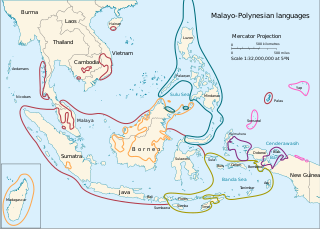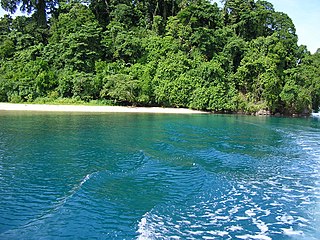
The Malayo-Polynesian languages are a subgroup of the Austronesian languages, with approximately 385.5 million speakers. The Malayo-Polynesian languages are spoken by the Austronesian peoples outside of Taiwan, in the island nations of Southeast Asia and the Pacific Ocean, with a smaller number in continental Asia in the areas near the Malay Peninsula, with Cambodia, Vietnam and the Chinese island Hainan as the northwest geographic outlier. Malagasy, spoken in the island of Madagascar off the eastern coast of Africa in the Indian Ocean, is the furthest western outlier.
The East Papuan languages is a defunct proposal for a family of Papuan languages spoken on the islands to the east of New Guinea, including New Britain, New Ireland, Bougainville, Solomon Islands, and the Santa Cruz Islands. There is no evidence that these languages are related to each other, and the Santa Cruz languages are no longer recognized as Papuan.

The approximately 450 Oceanic languages are a branch of the Austronesian languages. The area occupied by speakers of these languages includes Polynesia, as well as much of Melanesia and Micronesia. Though covering a vast area, Oceanic languages are spoken by only two million people. The largest individual Oceanic languages are Eastern Fijian with over 600,000 speakers, and Samoan with an estimated 400,000 speakers. The Gilbertese (Kiribati), Tongan, Tahitian, Māori and Tolai languages each have over 100,000 speakers. The common ancestor which is reconstructed for this group of languages is called Proto-Oceanic.

The Western Oceanic languages is a linkage of Oceanic languages, proposed and studied by Ross (1988).

The Papuan Tip languages are a branch of the Western Oceanic languages consisting of 60 languages.
The Huon Gulf languages are Western Oceanic languages spoken primarily in Morobe Province of Papua New Guinea. They may form a group of the North New Guinea languages, perhaps within the Ngero–Vitiaz branch of that family.
The Tolai language, or Kuanua, is spoken by the Tolai people of Papua New Guinea, who live on the Gazelle Peninsula in East New Britain Province.
Lungalunga, frequently though ambiguously called Minigir, is spoken by a small number of the Tolai people of Papua New Guinea, who live on the Gazelle Peninsula in East New Britain Province. It is often referred to in the linguistics literature as the Tolai "dialect" with an.

The Southern Oceanic languages are a linkage of Oceanic languages spoken in Vanuatu and New Caledonia. It was proposed by John Lynch in 1995 and supported by later studies. It appears to be a linkage rather than a language family with a clearly defined internal nested structure.
The Nalik language is spoken by 5,000 or so people, based in 17 villages in Kavieng District, New Ireland, Papua New Guinea. It is an Austronesian language and member of the New Ireland group of languages with a subject–verb–object (SVO) phrase structure. New Ireland languages are among the first Papua New Guinea languages recorded by Westerners.
Malcolm David Ross is an Australian linguist. He is the emeritus professor of linguistics at the Australian National University.
Vitu or Muduapa is an Oceanic language spoken by about 7,000 people on the islands northwest of the coast of West New Britain in Papua New Guinea.
Uneapa is an Oceanic language spoken by about 10,000 people on the small island of Bali (Uneapa), north of West New Britain in Papua New Guinea. It is perhaps a dialect of neighboring Vitu. Uneapa is one of the most conservative Oceanic languages, having retained most of Proto-Oceanic's final consonants with an echo vowel, such as *Rumaq 'house' > rumaka and *saqat 'bad' > zaɣata.
Proto-Oceanic is a proto-language that historical linguists since Otto Dempwolff have reconstructed as the hypothetical common ancestor of the Oceanic subgroup of the Austronesian language family. Proto-Oceanic is a descendant of the Proto-Austronesian language (PAN), the common ancestor of the Austronesian languages.
The family of Northwest Solomonic languages is a branch of the Oceanic languages. It includes the Austronesian languages of Bougainville and Buka in Papua New Guinea, and of Choiseul, New Georgia, and Santa Isabel in Solomon Islands.
The Doga language is an Austronesian language spoken by about 200 people along Cape Vogel in the Milne Bay Province of Papua New Guinea.
Teop is a language of northern Bougainville, Papua New Guinea. It falls within the Oceanic languages, a subgrouping of the Austronesian language family. According to Malcolm Ross, Teop belongs to the Nehan-Bougainville family of languages, part of the Northwest Solomonic group of the Meso-Melanesian cluster within the Oceanic languages. Its closest relative is Saposa.
The Niwer Mil language is spoken by 9,033 people on Boang Island, Malendok Island, Lif Island and Tefa Island in the Tanga Islands, Namatanai District of New Ireland Province in Papua New Guinea. It was split from the Tangga language in 2013. It is one of the languages that form the St George linkage group of Meso-Melanesian languages.

The Stettin Bay, also spelled as Stetin Bay, is a bay in the Bismarck Sea, within the Pacific Ocean, on the north coast of the island of New Britain. It is located in the Kimbe Bay, between the Willaumez Peninsula to the east, and Hoskins Peninsula to the west, within the West New Britain Province, Papua New Guinea.
The St. George linkage links the North-West Solomonic and New Ireland languages under the Meso-Melanesian languages. Members of the St George linkage are Niwer Mil language, Warwar Feni, Fanamaket, Sursurunga, Konomala, Patpatar, Tolai, Kandas, Ramoaina, Lungalunga, Label, Bilur, and Siar.




